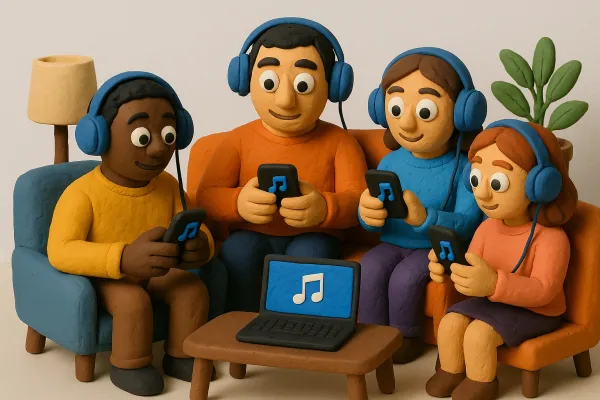Mastering Playlist Pitching: Essential Strategies for Indie Artists in 2025

In the ever-evolving music landscape, indie artists face the challenge of standing out amidst a sea of talent. One effective way to gain visibility is through playlist pitching. This article will explore essential strategies for indie musicians to master playlist pitching in 2025, helping them connect with audiences and grow their fan base.
Key Takeaways
- Understand the basics of playlist pitching and its significance for indie artists.
- Prepare your artist profile and music quality before reaching out to curators.
- Build genuine relationships with playlist curators for better chances of success.
- Avoid common pitfalls like targeting the wrong playlists or missing deadlines.
- Utilize analytics to measure your success and adapt your strategies accordingly.
Understanding Playlist Pitching
What Is Playlist Pitching?
Alright, let's kick things off with the basics—what exactly is playlist pitching? In simple terms, it's the art of getting your music onto playlists, whether they're massive editorial lists or smaller, niche ones. Think of it like trying to get your music on the radio, but for the streaming world. For indie artists, landing a spot on a playlist can be a game-changer. It might mean the difference between staying under the radar or having your track blow up overnight.
Why Playlist Pitching Matters
So, why should we care about playlist pitching? It's all about reaching new ears. Getting your song on a playlist can introduce your music to thousands or even millions of listeners who might never have found it otherwise. Plus, studies show a huge chunk of users discover new music through playlists. It's a direct line to potential fans and can seriously boost your streams and visibility.
How Playlist Pitching Works
Now, let's break down how this whole pitching thing actually works:
- Research Playlists: First up, find playlists that vibe with your music's style and genre.
- Prepare Your Pitch: Craft a submission that tells your story and makes your music shine.
- Submit to Curators: Use platforms or services like Pitch-Us' Spotify Playlist Pitching Service to connect with curators.
- Track Your Progress: Keep an eye on your streams and engagement to see how things are going.
Playlist pitching isn't just about getting your song out there; it's about finding the right ears to listen. When done right, it's like having a secret weapon in your music career toolkit.
Preparing for Your Pitch
Optimizing Your Artist Profile
Alright, folks, let’s talk about how to make your artist profile shine. First impressions matter, especially in the music world. So, start by sprucing up your profile with some high-quality images and a killer bio. Make sure it’s professional but still shows off your personality. Don’t forget to link your social media accounts. This not only helps fans connect with you but also gives curators a way to see what you’re all about. Keep your profile fresh with updates on new releases and playlists.
Creating High-Quality Music
Now, onto the music itself. We can’t stress enough how important it is to put out tracks that are polished and professional. Curators want to hear music that’s well-produced, mixed, and mastered. It’s not just about having a catchy tune; it’s about delivering a complete package that sounds great from start to finish. Consider investing in professional production if you can. It really makes a difference.
Researching Target Playlists
Before you start pitching, you gotta do your homework. Research is key. Look for playlists that fit your genre and vibe. You want to find those that align with your music style and audience. Make a list of potential playlists and check out their submission guidelines. Some curators are super specific about what they want, so pay attention to those details. It’s like finding the right audience for your music promotion. The more targeted your approach, the better your chances of getting noticed.
The Best Playlist Pitching Strategies
Using Professional Services
Alright, let's dive into the nitty-gritty of playlist pitching. First up, using a professional playlist pitching service can be a game-changer. These services connect your tracks with curators who are constantly on the lookout for fresh sounds. It's like having a buddy who knows all the right people. They streamline the process, making sure your music lands in the right ears. But hey, it's not just about tossing your music into the ether. You gotta make sure the service aligns with your goals and budget. Some of the popular ones include Playlist Push, which helps artists get their tracks into Spotify playlists, boosting their reach and exposure.
Building Relationships with Curators
Now, let's talk about building relationships. This isn't about sliding into DMs with a "Hey, listen to my track!" It's more like nurturing a friendship. Start by genuinely engaging with curators' content. Comment on their posts, share their playlists, and show some love. Curators are more likely to give your track a spin if they recognize your name and know you're not just another random artist. It's all about being part of the community, not just a guest.
Focusing on Quality Over Quantity
Lastly, let's focus on quality over quantity. It's tempting to pitch to every playlist under the sun, but trust me, that's a one-way ticket to nowhere. Instead, hone in on playlists that truly resonate with your style and audience. A well-targeted pitch to a few key playlists can have a way bigger impact than a scattergun approach. Make sure your music is polished, your pitch is on point, and your profile is looking sharp. Remember, it's better to be a big fish in a small pond than a tiny fish in an ocean of playlists.
Before you hit send on that pitch, take a moment to listen to your track with fresh ears. Is it really ready to be showcased? If not, take the time to tweak and polish. It's like dressing up for a big night out—you want to look and sound your best.
Common Mistakes in Playlist Pitching
Pitching to the Wrong Playlists
Alright, let's talk about a classic blunder: pitching to playlists that just don't fit your music. It's like trying to sell snow boots in the desert—wrong place, wrong time. We need to research and target the right playlists that align with our style and vibe. Think about genre, mood, and even the playlist's audience. If our tunes don't match, it's a no-go.
Ignoring Submission Deadlines
Deadlines are a big deal, folks. Miss one, and our pitch might as well be a love letter never sent. Editorial playlists, especially, have strict timelines. We should aim to submit at least a week before our release date. Mark those calendars and set reminders—whatever it takes to stay on track.
Skipping Profile Optimization
Imagine showing up to a job interview in pajamas. That's what it's like when we pitch with an incomplete artist profile. Curators want to see a polished image, so let's make sure our profile is on point. High-quality images, a snappy bio, and links to our social media are a must. A well-optimized profile can make all the difference.
"In the world of playlist pitching, preparation isn't just helpful—it's everything. Our profile is often the first impression, and we only get one shot to make it count."
Measuring Your Success
Tracking Plays and Engagement
Alright, let's dive into the nitty-gritty of tracking your music's performance. First things first, we need to keep an eye on those streaming numbers. How many plays are your songs getting? Which tracks are your fans loving the most? Understanding your streaming data means understanding your audience. Check out where your listeners are tuning in from and what playlists are already featuring your tracks. This info isn't just cool to know—it’s your secret weapon for pitching.
Analyzing Audience Demographics
Knowing your audience is key. Dive into the demographics of your listeners. Are they mostly from the U.S., or do you have a surprising fan base in Brazil? Are they teenagers or middle-aged rockers? This info helps tailor your pitches and even your future music. You might discover that your ballads are big with the 30-somethings, while your upbeat tracks are a hit with the college crowd.
Adjusting Your Strategy Based on Data
Once you've got a handle on your data, it's time to tweak your approach. Maybe you need to pitch more of those tracks that are doing well in certain regions or switch up your style a bit to match the tastes of your audience. It's all about adapting and evolving. Remember, folks, using data effectively can be the difference between your song getting lost in the shuffle and it becoming the next big hit.
Data isn't just numbers; it's the story of your music's journey. The more you know about your music's performance and the playlist landscape, the better your chances of landing that coveted spot.
And hey, if you're looking to up your game, consider choosing the right playlist pitching service that aligns with your goals and helps you track your success over time.
Emerging Trends in Playlist Pitching
AI and Playlist Discovery
Alright, folks, let's talk about what's cooking in the world of playlist pitching. AI is taking center stage, making it easier for artists to find the right playlists. We're talking smarter algorithms that match your tracks with playlists that fit like a glove. It's like having a personal assistant who knows all the right people. AI-powered tools are now analyzing your music and suggesting the best playlists to pitch to. It's all about making your life easier and your music more discoverable.
The Rise of Niche Playlists
Gone are the days when only the big playlists mattered. Now, it's all about those niche playlists with super-engaged audiences. These playlists might not have millions of followers, but the folks who do follow them are genuinely interested in the music. They listen, they share, and they even recommend your tracks to their friends. So, don't overlook these smaller, more focused playlists. They're a goldmine for indie artists trying to break into specific markets.
Social Media's Role in Pitching
Social media is playing a bigger role in playlist pitching than ever before. Curators are hanging out on platforms like Instagram and TikTok, checking out what's buzzing. So, if you're not already using social media to promote your music, now's the time to start. Share your tracks, engage with fans, and make some noise. You never know when a curator might stumble across your profile and decide to add your song to their playlist.
In a world where music discovery is constantly evolving, staying ahead of the trends can make all the difference. Embrace these changes, and you'll find new ways to get your music heard.
Inspiring Stories from Indie Artists
Success Through Persistence
You know, some folks think making it in music is all about that one lucky break. But honestly, for most indie artists, it's about sticking with it. There's this one band I know, they played in every tiny bar and coffee shop for years. They were on the verge of calling it quits when a single playlist feature on Spotify suddenly put them in front of thousands of listeners. Persistence really pays off.
The Power of Small Wins
We often focus on the big wins, but sometimes it's the little victories that keep us going. Take that time when an artist got picked up by a small, niche playlist. It wasn't a huge deal at first, but that playlist had a loyal following. Those listeners became fans, and those fans spread the word. One small win can lead to bigger things.
Lessons Learned from the Journey
Every artist's path is different, but there are some common lessons. First, never underestimate the power of your story. People connect with authenticity. Second, be open to feedback. It might sting, but it's how we grow. And finally, keep learning. The music scene is always changing, and staying informed is key to staying relevant.
"It's a marathon, not a sprint. Keep pushing, keep creating, and who knows? Your next track might just be the one to break through."
Check out the amazing journeys of indie artists who have followed their dreams and created beautiful music. Their stories show us that with hard work and passion, anything is possible. Want to learn more about these inspiring artists? Visit our website for more stories and updates!
Wrapping It Up: Your Playlist Pitching Journey
So, there you have it! Getting your music on Spotify playlists in 2025 isn’t some secret formula, but it does require some effort and a bit of strategy. Remember, it’s all about building those connections, knowing what curators want, and showcasing your music in the best light. Don’t get discouraged if things don’t happen overnight. Keep pushing your tunes, stay consistent with your pitches, and who knows? Your next track could be the one that gets you noticed. Just keep at it!
Frequently Asked Questions
What does playlist pitching mean?
Playlist pitching is when you send your music to people who create playlists. You hope they will add your song to their playlist, which can help you reach more listeners.
Why is playlist pitching important for indie artists?
It's important because getting your song on a playlist can introduce you to many new fans. A good playlist can help your music get heard by thousands of people.
How do I prepare for playlist pitching?
To prepare, make sure your music is high quality, have a good artist profile, and research playlists that fit your style.
What are common mistakes in playlist pitching?
Common mistakes include sending your music to the wrong playlists, missing submission deadlines, and not having a complete artist profile.
How can I measure my success in playlist pitching?
You can measure success by tracking how many people listen to your song and looking at data about your audience. This helps you see what works and what doesn’t.
What are some new trends in playlist pitching?
Some new trends include using AI to find playlists and the growth of niche playlists that focus on specific music styles.





